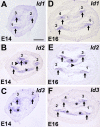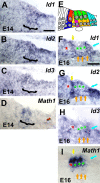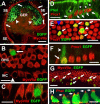Inhibitors of differentiation and DNA binding (Ids) regulate Math1 and hair cell formation during the development of the organ of Corti
- PMID: 16407553
- PMCID: PMC6674393
- DOI: 10.1523/JNEUROSCI.3859-05.2006
Inhibitors of differentiation and DNA binding (Ids) regulate Math1 and hair cell formation during the development of the organ of Corti
Abstract
The basic helix-loop-helix (bHLH) transcription factor Math1 (also called Atoh1) is both necessary and sufficient for hair cell development in the mammalian cochlea (Bermingham et al., 1999; Zheng and Gao, 2000). Previous studies have demonstrated that a dynamic pattern of Math1 expression plays a key role in regulating the number and position of mechanosensory hair cells. However, the factors that regulate the temporal and spatial expression of Math1 within the cochlea are unknown. The bHLH-related inhibitors of differentiation and DNA binding (Id) proteins are known to negatively regulate many bHLH transcription factors, including Math1, in a number of different systems. Therefore, Id proteins are good candidates for regulating Math1 in the cochlea. Results from PCR and in situ hybridization indicate that Id1, Id2, and Id3 are expressed within the cochlear duct in a pattern that is consistent with a role in regulation of hair cell development. In particular, expression of Ids and Math1 overlapped in cochlear progenitor cells before cellular differentiation, but a specific downregulation of Id expression was observed in individual cells that differentiated as hair cells. In addition, progenitor cells in which the expression of Ids was maintained during the time period for hair cell differentiation were inhibited from developing as hair cells. These results indicate a key role for Ids in the regulation of expression of Math1 and hair cell differentiation in the developing cochlea.
Figures





Similar articles
-
The expression and roles of inhibitor of DNA binding helix-loop-helix proteins in the developing and adult mouse retina.Neuroscience. 2011 Feb 23;175:367-79. doi: 10.1016/j.neuroscience.2010.12.007. Epub 2010 Dec 9. Neuroscience. 2011. PMID: 21145943
-
Id gene regulation and function in the prosensory domains of the chicken inner ear: a link between Bmp signaling and Atoh1.J Neurosci. 2010 Aug 25;30(34):11426-34. doi: 10.1523/JNEUROSCI.2570-10.2010. J Neurosci. 2010. PMID: 20739564 Free PMC article.
-
Math1 gene transfer generates new cochlear hair cells in mature guinea pigs in vivo.J Neurosci. 2003 Jun 1;23(11):4395-400. doi: 10.1523/JNEUROSCI.23-11-04395.2003. J Neurosci. 2003. PMID: 12805278 Free PMC article.
-
Development in the Mammalian Auditory System Depends on Transcription Factors.Int J Mol Sci. 2021 Apr 18;22(8):4189. doi: 10.3390/ijms22084189. Int J Mol Sci. 2021. PMID: 33919542 Free PMC article. Review.
-
Cellular commitment and differentiation in the organ of Corti.Int J Dev Biol. 2007;51(6-7):571-83. doi: 10.1387/ijdb.072388mk. Int J Dev Biol. 2007. PMID: 17891718 Review.
Cited by
-
A dual function for canonical Wnt/β-catenin signaling in the developing mammalian cochlea.Development. 2012 Dec 1;139(23):4395-404. doi: 10.1242/dev.080358. Development. 2012. PMID: 23132246 Free PMC article.
-
Age-related transcriptome changes in Sox2+ supporting cells in the mouse cochlea.Stem Cell Res Ther. 2019 Dec 2;10(1):365. doi: 10.1186/s13287-019-1437-0. Stem Cell Res Ther. 2019. PMID: 31791390 Free PMC article.
-
The regulation of gene expression in hair cells.Hear Res. 2015 Nov;329:33-40. doi: 10.1016/j.heares.2014.12.013. Epub 2015 Jan 21. Hear Res. 2015. PMID: 25616095 Free PMC article. Review.
-
The acquisition of positional information across the radial axis of the cochlea.Dev Dyn. 2020 Mar;249(3):281-297. doi: 10.1002/dvdy.118. Epub 2019 Oct 24. Dev Dyn. 2020. PMID: 31566832 Free PMC article. Review.
-
The transcriptome of utricle hair cell regeneration in the avian inner ear.J Neurosci. 2014 Mar 5;34(10):3523-35. doi: 10.1523/JNEUROSCI.2606-13.2014. J Neurosci. 2014. PMID: 24599453 Free PMC article.
References
-
- Andres-Barquin PJ, Hernandez MC, Israel MA (2000) Id genes in nervous system development. Histol Histopathol 15: 603–618. - PubMed
-
- Anniko M (1983) Cytodifferentiation of cochlear hair cells. Am J Otolaryngol 4: 375–388. - PubMed
-
- Benezra R, Davis RL, Lockshon D, Turner DL, Weintraub H (1990) The protein Id: a negative regulator of helix-loop-helix DNA binding proteins. Cell 61: 49–59. - PubMed
-
- Bermingham NA, Hassan BA, Price SD, Vollrath MA, Ben-Arie N, Eatock RA, Bellen HJ, Lysakowski A, Zoghbi HY (1999) Math1: an essential gene for the generation of inner ear hair cells. Science 284: 1837–1841. - PubMed
-
- Bermingham-McDonogh O, Stone J, Hume C, Oesterle E (2005) Developmental expression of the homeobox transcription factor Prox1 in the murine organ of Corti. Assoc Res Otolaryngol Abstr 1353.
Publication types
MeSH terms
Substances
Grants and funding
LinkOut - more resources
Full Text Sources
Molecular Biology Databases
